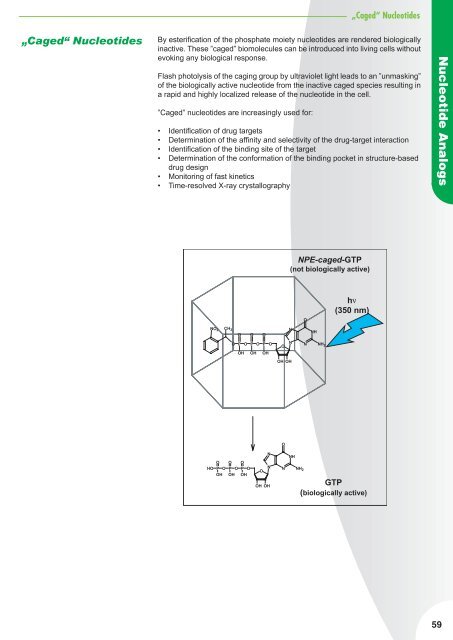- Page 1 and 2:
JENA BIOSCIENCE Nucleotides and the
- Page 3 and 4:
2 Imprint: Design and Layout by: Gr
- Page 5 and 6:
Fax Order Form 4 Jena Bioscience Fa
- Page 7 and 8:
Terms/Conditions 6 General Business
- Page 9 and 10: 8 http://www.jenabioscience.com
- Page 11 and 12: Nucleotide Analogs 10 General Infor
- Page 13 and 14: Nucleotide Analogs 12 Fluorescent C
- Page 15 and 16: Nucleotide Analogs 14 Labeled Amino
- Page 17 and 18: Nucleotide Analogs 16 Labeled Cytid
- Page 19 and 20: Nucleotide Analogs 18 Labeled γ-Am
- Page 21 and 22: Nucleotide Analogs 20 Labeled with
- Page 23 and 24: Nucleotide Analogs 22 Labeled with
- Page 25 and 26: Nucleotide Analogs 24 Labeled with
- Page 27 and 28: Nucleotide Analogs 26 Intrinsically
- Page 29 and 30: Nucleotide Analogs 28 Selected refe
- Page 31 and 32: Nucleotide Analogs 30 mant-GTPγS 2
- Page 33 and 34: Nucleotide Analogs 32 http://www.je
- Page 35 and 36: Nucleotide Analogs 34 Labeled Cytid
- Page 37 and 38: Nucleotide Analogs 36 Labeled 8-[(4
- Page 39 and 40: Nucleotide Analogs 38 Non-hydrolyza
- Page 41 and 42: Nucleotide Analogs 40 dATPαS 2‘-
- Page 43 and 44: Nucleotide Analogs 42 Selected refe
- Page 45 and 46: Nucleotide Analogs 44 XTPγS Xantho
- Page 47 and 48: Nucleotide Analogs 46 Bisubstrate I
- Page 49 and 50: Nucleotide Analogs 48 Halogen conta
- Page 51 and 52: Nucleotide Analogs 50 Hei et al. (1
- Page 53 and 54: Nucleotide Analogs 52 Amine-labeled
- Page 55 and 56: Nucleotide Analogs 54 Other Bases
- Page 57 and 58: Nucleotide Analogs 56 dATPαS 2‘-
- Page 59: Nucleotide Analogs 58 γ-Aminohexyl
- Page 63 and 64: Nucleotide Analogs 62 d4TTP 2’,3
- Page 65 and 66: Nucleotide Analogs 64 6-Thio-GTP 6-
- Page 67 and 68: Nucleotide Analogs 66 Cyclic Nucleo
- Page 69 and 70: Nucleotide Analogs 68 m 7 GTP 7-Met
- Page 71 and 72: Nucleotide Analogs 70 XTP Xanthosin
- Page 73 and 74: Nucleotide Analogs 72 Vial et al. (
- Page 75 and 76: Nucleotide Analogs 74 Non-modifi ed
- Page 77 and 78: 76 http://www.jenabioscience.com
- Page 79 and 80: Macromolecular Crystallography 78 C
- Page 81 and 82: Macromolecular Crystallography 80 J
- Page 83 and 84: Macromolecular Crystallography 82 J
- Page 85 and 86: Macromolecular Crystallography 84 J
- Page 87 and 88: Macromolecular Crystallography 86 J
- Page 89 and 90: Macromolecular Crystallography 88 J
- Page 91 and 92: Macromolecular Crystallography 90 J
- Page 93 and 94: Macromolecular Crystallography 92 J
- Page 95 and 96: Macromolecular Crystallography 94 W
- Page 97 and 98: Macromolecular Crystallography 96 O
- Page 99 and 100: Macromolecular Crystallography 98 J
- Page 101 and 102: Macromolecular Crystallography 100
- Page 103 and 104: Macromolecular Crystallography 102
- Page 105 and 106: Macromolecular Crystallography 104
- Page 107 and 108: Macromolecular Crystallography 106
- Page 109 and 110: Macromolecular Crystallography 108
- Page 111 and 112:
Macromolecular Crystallography 110
- Page 113 and 114:
Macromolecular Crystallography 112
- Page 115 and 116:
114 http://www.jenabioscience.com
- Page 117 and 118:
LEXSY 116 http://www.jenabioscience
- Page 119 and 120:
LEXSY 118 http://www.jenabioscience
- Page 121 and 122:
LEXSY 120 Secretory expression of t
- Page 123 and 124:
LEXSY 122 Synthetic serum- and prot
- Page 125 and 126:
LEXSY 124 Important licensing infor
- Page 127 and 128:
Recombinant Proteins 126 GTP Signal
- Page 129 and 130:
Recombinant Proteins 128 K-Ras 4B h
- Page 131 and 132:
Recombinant Proteins 130 Rab17 mous
- Page 133 and 134:
Recombinant Proteins 132 Selected r
- Page 135 and 136:
Recombinant Proteins 134 WASP-121 G
- Page 137 and 138:
Recombinant Proteins 136 G sαS -Le
- Page 139 and 140:
Recombinant Proteins 138 Store: -80
- Page 141 and 142:
Recombinant Proteins 140 Wenzel-Sei
- Page 143 and 144:
Recombinant Proteins 142 Mutation o
- Page 145 and 146:
Recombinant Proteins 144 Naunyn- Sc
- Page 147 and 148:
Recombinant Proteins 146 Protein co
- Page 149 and 150:
Recombinant Proteins 148 Membrane P
- Page 151 and 152:
Recombinant Proteins 150 TBP (TATA
- Page 153 and 154:
Recombinant Proteins 152 Store: -80
- Page 155 and 156:
Recombinant Proteins 154 RAP30 can
- Page 157 and 158:
Recombinant Proteins 156 and contai
- Page 159 and 160:
Recombinant Proteins 158 BRCA1 (Tum
- Page 161 and 162:
Recombinant Proteins 160 Unit defi
- Page 163 and 164:
Recombinant Proteins 162 p53, wild
- Page 165 and 166:
Recombinant Proteins 164 Sp1 (GC-bo
- Page 167 and 168:
Recombinant Proteins 166 p52 (Trans
- Page 169 and 170:
Recombinant Proteins 168 Topo I (Hu
- Page 171 and 172:
Recombinant Proteins 170 HMG1 (High
- Page 173 and 174:
Recombinant Proteins 172 Splicing F
- Page 175 and 176:
Recombinant Proteins 174 Lim-Tio et
- Page 177 and 178:
Recombinant Proteins 176 GST-LXRα-
- Page 179 and 180:
Recombinant Proteins 178 Unit defi
- Page 181 and 182:
Recombinant Proteins 180 Purity: >
- Page 183 and 184:
Recombinant Proteins 182 PI3 Kinase
- Page 185 and 186:
Recombinant Proteins 184 Selected r
- Page 187 and 188:
Recombinant Proteins 186 L-α-Phosp
- Page 189 and 190:
Recombinant Proteins 188 , Tyrosine
- Page 191 and 192:
Recombinant Proteins 190 Purity: >
- Page 193 and 194:
Recombinant Proteins 192 p42/ERK2/M
- Page 195 and 196:
Recombinant Proteins 194 Akt3/PKBγ
- Page 197 and 198:
Recombinant Proteins 196 CK2 substr
- Page 199 and 200:
Recombinant Proteins 198 PTP 1B is
- Page 201 and 202:
Recombinant Proteins 200 Prion Prot
- Page 203 and 204:
Recombinant Proteins 202 Ovine (She
- Page 205 and 206:
Recombinant Proteins 204 bovPrPc cD
- Page 207 and 208:
Recombinant Proteins 206 HIV-1 Nef
- Page 209 and 210:
Recombinant Proteins 208 Antioxidan
- Page 211 and 212:
Recombinant Proteins 210 Interleuki
- Page 213 and 214:
Enzymes 212 Restriction Enzymes Res
- Page 215 and 216:
Enzymes 214 http://www.jenabioscien
- Page 217 and 218:
Enzymes 216 Restriction Enzymes Buf
- Page 219 and 220:
Enzymes 218 Relative Activity of Re
- Page 221 and 222:
Enzymes 220 Acc I 5’...GTMKAC...3
- Page 223 and 224:
Enzymes 222 EcoR V 5’...GATATC...
- Page 225 and 226:
Enzymes 224 Sca I 5’...AGTACT...3
- Page 227 and 228:
Enzymes 226 Selected references: Br
- Page 229 and 230:
Enzymes 228 GST-RPB9 (RNA Polymeras
- Page 231 and 232:
Enzymes 230 T4 dNMP kinase Bacterio
- Page 233 and 234:
Enzymes 232 Topo I Core (Human DNA
- Page 235 and 236:
234 http://www.jenabioscience.com
- Page 237 and 238:
Antibodies 236 Transcription Factor
- Page 239 and 240:
Antibodies 238 anti-Dr1 rabbit poly
- Page 241 and 242:
Antibodies 240 PI3 Kinase Antibodie
- Page 243 and 244:
242 http://www.jenabioscience.com
- Page 245 and 246:
PCR related Products 244 Standard P
- Page 247 and 248:
PCR related Products 246 DNA Mutage
- Page 249 and 250:
PCR related Products 248 Polymerase
- Page 251 and 252:
PCR related Products 250 Primers an
- Page 253 and 254:
PCR related Products 252 DNA Sequen
- Page 255 and 256:
PCR related Products 254 50 bp DNA
- Page 257 and 258:
Affi nity Chromatography 256 Immobi
- Page 259 and 260:
Affi nity Chromatography 258 Immobi
- Page 261 and 262:
Affi nity Chromatography 260 γ-Ami
- Page 263 and 264:
Affi nity Chromatography 262 Immobi
- Page 265 and 266:
Affi nity Chromatography 264 γ-Ami
- Page 267 and 268:
Affi nity Chromatography 266 Immobi
- Page 269 and 270:
Affi nity Chromatography 268 2’/3
- Page 271 and 272:
Index 270 Product Catalog number Pa
- Page 273 and 274:
Index 272 Labeled 5-Propargylamino-
- Page 275 and 276:
Index 274 Labeled EDA-ATP + 5-FAM..
- Page 277 and 278:
Index 276 Labeled γ-Aminooctyl-dUT
- Page 279 and 280:
Index 278 Constitutive LEXSY Starte
- Page 281 and 282:
Index 280 PrPc (full length, residu
- Page 283 and 284:
Index 282 dPTP, L pack ............
- Page 285 and 286:
Index 284 Catalog number Product Pa
- Page 287 and 288:
Index 286 CC-105 JBScreen Cryo 3 ..
- Page 289 and 290:
Index 288 NU-1014L NTP bundle (larg
- Page 291 and 292:
Index 290 NU-407S AppNHp (AMPPNP) .
- Page 293 and 294:
Index 292 NU-810-540Q Labeled EDA-A
- Page 295 and 296:
Index 294 NU-819L γ-Aminoethyl-App
- Page 297 and 298:
Index 296 PR-306 RCC1 (RanGEF) ....



